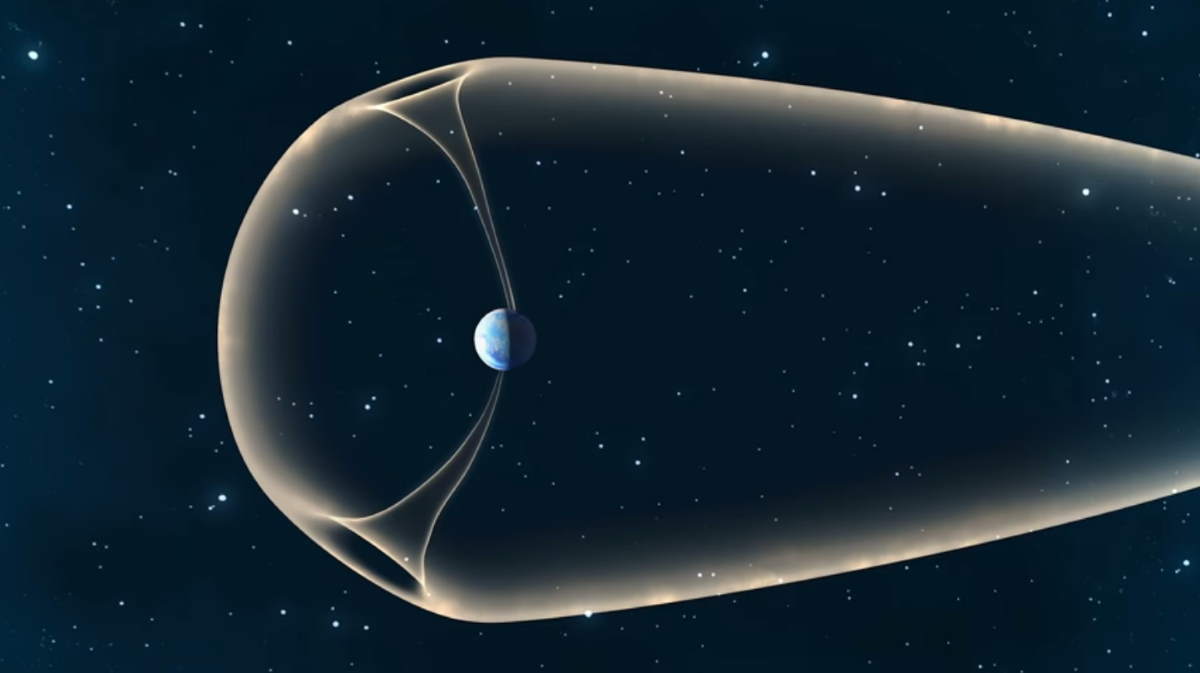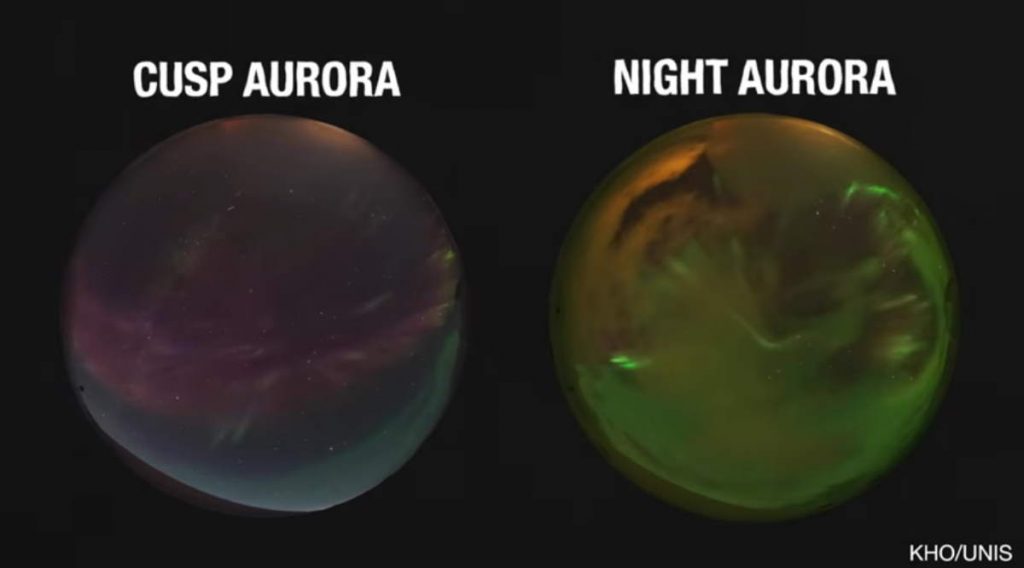Earth’s atmosphere is leaking: around 90 tonnes of material escapes and streams out into space from our planet’s upper atmosphere every single day.
To understand this escape, NASA launches rockets into space. The space agency also sends scientists to a tiny Arctic town named Ny-Ålesund (English: New Alesund) on the island of Spitsbergen in Svalbard, Norway. Because understanding this atmospheric escape on Earth can benefit us in many ways – from predicting which exoplanets might be habitable, to piecing together how Mars became the desolate, exposed planet it is today.
Why Earth’s atmosphere is leaking?
First of all, this leak bears no danger. 90 tonnes per day is a very small amount compared to the complete mass of the Earth’s atmosphere – which is 5 x 1015 tonnes.
In other words, it would take at least 152 billion years to escape all our atmosphere into space. Our planet will be long gone before that happens.

Earth’s magnetic field protects us (and our atmosphere) from the solar wind, a stream of charged particles emanating from the Sun. Without it, these charged particles (and cosmic rays which originate from the sun, from outside of the solar system, or even from distant galaxies) would strip away the upper atmosphere. And, gradually, in a few billion years, our planet would lose its atmosphere, like today’s Mars.
Mars has no magnetosphere, so it lost much of its atmosphere over billions of years. This loss transformed the red planet’s climate from one that might have supported life into the dry and frozen desert of today.
The magnetic field of Earth acts like a shield.
However, it also has weaknesses. Above Earth’s poles, the field lines are open, like those of a standard bar magnet. These locations are called “polar cusps”. From the cusps, solar wind particles can head inwards towards Earth, filling up the magnetosphere with energetic particles.
Here, particles can also head outwards. This is how the Earth’s atmospheric loss happens: our planet’s atmosphere leaks to space from the cusps. But the processes involved remain unclear.
The Norwegian island of Spitsbergen lies beneath one of two polar cusps of Earth. That’s why NASA sent scientists there.
NASA is sending rockets into Earth’s leaky atmosphere
Douglas Rowland, the Chief of the Ionosphere, Thermosphere, Mesosphere Physics Laboratory in the Heliophysics Science Division at NASA Goddard Space Flight Center is the leader of these scientists. He says:
“What we’re trying to understand is how did Earth’s atmosphere evolve over time and how do other planets that might be like Earth or more dissimilar to Earth, how did their atmospheres evolve.”
Rowland joined forces with Jøran Moen, a professor at the University of Oslo (UiO), who started The Grand Challenge Initiative (GCI).
GCI is a large-scale international collaboration effort targeting advancement in specific, fundamental issues in space and earth science.
The first GCI project, GCI Cusp aims to determine the multi-scale physics of heating and charged particle precipitation in the ionosphere specific to the geomagnetic cusp region. The project is designed to advance the common understanding of cusp region space physics through coordinated experimental and theoretical research using ground-based instruments, modeling, sounding rocket investigations, and satellite-based instruments.
In cooperation with NASA and the Japanese Aerospace Exploration Agency, the project includes launching eleven rockets to the upper atmosphere.
Rowland is the mission leader for the first two rockets of the campaign.
Sounding rockets
The team is using sounding rockets, which are different than bigger rockets that carry satellites and humans into space.
Sometimes called a research rocket, a sounding rocket is an instrument-carrying rocket designed to take measurements and perform scientific experiments during its sub-orbital flight. Their altitude is generally between weather balloons and satellites. The maximum altitude for balloons is about 25 mi (40 km) and the minimum for satellites is approximately 75 mi (121 km).
Certain sounding rockets have an apogee between 620 and 930 miles (1,000 and 1,500 km), such as the Black Brant X and XII, though.
Cusp team’s rockets fly briefly into space, collect realtime data for 15 minutes, then fall back to Earth. They are quite affordable, quick to build, and can launch towards a precise point.
But there’s a limited launch window and only one chance to get the launch right. If it’s a windy day, for example, you can’t launch the rocket.
VISIONS-2
The mission is named VISIONS-2, an abbreviation for The Visualizing Ion Outflow via Neutral Atom Sensing-2.
In short, mission scientists are looking at how oxygen is getting enough energy to escape into space. Rowland explains:
“Earth’s gravity should hold onto the oxygen, and yet, we see this gas shooting off into space. We’re trying to figure out how that works.”
Moen adds:
“That is a science question that has been hanging around for four decades.”
Cusp aurora
In fact, anyone can see the Earth’s atmosphere leaking into space at the right place and time. In Svalbard, for example, during the winter months, polar nights occur – constant darkness that lasts 24 hours.
This continual darkness is key for witnessing the atmospheric escape. This phenomenon is called the “Cusp Aurora”. It’s a special type of northern lights (aurora borealis) that appears between 8 a.m. and noon. So, you can only see it when it’s dark during the day. That’s why the VISIONS-2 team traveled to Svalbard.
It looks similar to the aurora that occurs at night. But, during a Cusp aurora, 90-100 tons of oxygen escapes from Earth’s atmosphere into space.

The VISIONS-2 team chases these Cusp auroras. Sometimes they use radars to track it if the sky is cloudy. They also use a collection of data from satellites and ground instruments that helps them predict where the cusp aurora will be.
Earth’s cusps are not fixed points in space. They actually move around because of the solar wind.
Project scientist Sophia Zaccarine explains:
“When energy is released from the Sun, via a solar flare or a coronal mass ejection, all of that energy in the form of radiation rides down the magnetic field lines of Earth and is transferred and dumped into the Earth’s atmosphere.”
Electrons accelerate and collide with oxygen particles, giving them energy to release light (curb aurora) and sometimes enough energy to escape.
Scientists chase the curb auroras to launch rockets, but a rocket cannot be launched at any time. Wind, especially, is critical. You can watch in the video above how a stressful process it is.
Zaccarine says:
“When we kind of started seeing this really good data, this clock started counting down, and that’s when everyone realized this is going to happen. We’re going to launch.”
Projects scientist John Hickman:
“We’re doing everything we can to get that launch off before the aurora goes away, and it’s really, really challenging and nerve-wracking at that point. You can see the tension just rise in everybody when that happens.”
Zaccarine adds:
“And we immediately turn around and ran right back in to look at all the data that was coming back from the instruments. You know how much time and effort went into it because we all worked on it and there’s just nothing that compares to that feeling.”
“This is a story about what it takes to launch science instruments into space. But the real adventure will be in the data they sent back. Hidden within the numbers will be the answers that reach far beyond Earth, shedding light on how atmospheres throughout the universe change, evolve, and perhaps, support life.”
Read more
NASA has published a long blog post series titled “A shot in the dark – Chasing the aurora from the world’s northernmost rocket range” covering experiments, researches, and scientists’ stories in a tiny nordic town where polar bears outnumber humans.
“In the tiny Arctic town of Ny-Ålesund, where polar bears outnumber people, winter means three months without sunlight. The unending darkness is ideal for those who seek a strange breed of northern lights, normally obscured by daylight. When these unusual auroras shine, Earth’s atmosphere leaks into space.”
“NASA scientists traveled to Ny-Ålesund to launch rockets through these auroras and witness oxygen particles right in the middle of their escape. Piercing these fleeting auroras, some 300 miles high, would require strategy, patience – and a fair bit of luck. This is their story.”
Sources
- “The curious case of Earth’s leaking atmosphere” by the European Space Agency on Phys.org
- “Where does Earth’s leaking atmosphere go?” on European Space Agency (ESA) Science website
- “VISIONS-2 Provides a Look at Earth’s Escaping Atmosphere” on NASA.gov
- “New insight into how much atmosphere Mars lost” on Phys.org
- The Grand Challenge Initiative official website
- Sounding rocket on Wikipedia
- How Many Elephants are Left in the World in 2025? - August 17, 2025
- Moon Landings: All-Time List [1966-2025] - February 2, 2025
- What Is Max-Q and Why Is It Important During Rocket Launches? - January 16, 2025